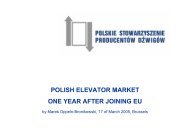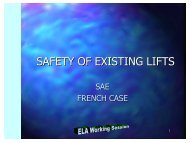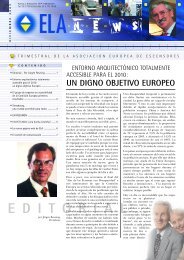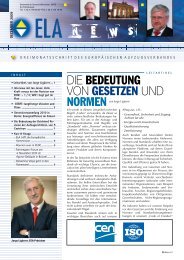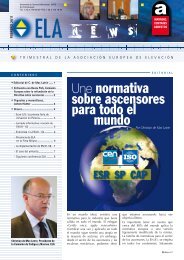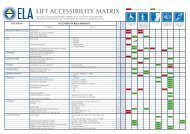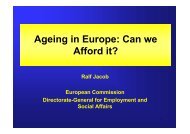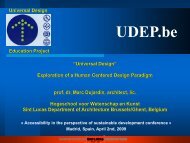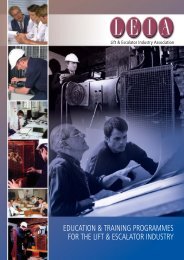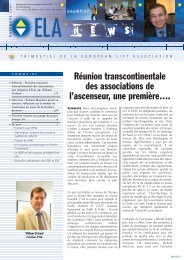WP6-Brochure-E4 brochure - ELA European Lift Association.
WP6-Brochure-E4 brochure - ELA European Lift Association.
WP6-Brochure-E4 brochure - ELA European Lift Association.
You also want an ePaper? Increase the reach of your titles
YUMPU automatically turns print PDFs into web optimized ePapers that Google loves.
Table 7‐1. Categories of stakeholders identified and actual coverage of interviews and survey.<br />
Stakeholder categories<br />
Manufacturer, installation,<br />
service & maintenance<br />
Architect, construction<br />
engineers, lift consultants<br />
Number of Interviews<br />
Construction company 1<br />
Building administrator and<br />
operator<br />
1<br />
Notified bodies 2<br />
Survey<br />
participants<br />
6 5<br />
3 5<br />
In sum, 13 interviews were conducted by ISI and 10 written surveys were collected by ISR‐UC<br />
and KAPE (6 and 4, respectively). The experts surveyed represented several <strong>European</strong><br />
countries, e.g. Germany, Switzerland, Italy, Portugal, and Poland. The <strong>European</strong> perspective is<br />
further broadened by two interviews conducted with representatives of <strong>European</strong> professional<br />
and industrial associations working in Brussels/Belgium.<br />
The interviews were usually conducted via telephone in German or English. An interview<br />
guideline was provided beforehand, based on a literature analysis [4] [5]. The guideline<br />
consisted of five parts. Part A asked participants to do a general assessment of the lift and<br />
escalator market regarding the salience of energy efficiency in the market, the most important<br />
criteria when choosing equipment, and differences between the lift and the escalator market.<br />
We also asked whether the interview partner thinks that investment in energy‐efficient<br />
technology in this sector pays off financially. Part B listed barriers – extracted from the<br />
literature – and asked participants for an opinion whether they thought that a barrier applies<br />
1) never or only in very few cases, 2) in some cases 3) in most cases. If they chose 3, they were<br />
then asked to comment in more detail on this issue. The list of barriers is presented in Table<br />
7‐2.<br />
Table 7‐2. List of barriers rated in the interviews.<br />
Barriers<br />
Information and transaction costs<br />
‣ Operators of lifts or escalators do not monitor the energy consumption and the<br />
energy costs of their installations.<br />
‣ Operators do not have a designated employee who is responsible for the energyrelated<br />
issues of lifts and escalators.<br />
‣ The decision‐maker is not aware of the energy consumption of the choice he or<br />
she makes.<br />
‣ It is difficult or impossible for the decision‐maker to obtain information about<br />
energy‐efficient technology.<br />
91



